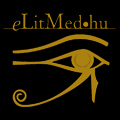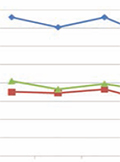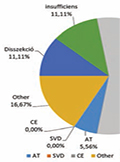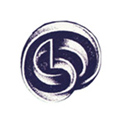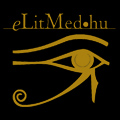The eLitMed.hu medical portal uses computer cookies for convenient operation. Detailed information can be found in the Cookie-policy.
Clinical Neuroscience - 2018;71(05-06)
Content
[Pharmacological and nonpharmacological treatment of insomnias with regard to sleep medicine]
[Insomnia - one of the most prevalent sleep complain - has a great impact on the everyday life. Basically two different form of insomnia can be defined: the insomnia disorder and the co-morbid insomnias. To treat adequately determination of background pathology is essential, which is based on the help of Sleep Medicine Centers. According to the newest guidelines, the treatment of insomnia disorder is based on cognitive behavioural therapies followed by pharmaceutical intervention. In this review we provide the short description of cognitive behavioural therapies and basic principles of hypnotic drugs. Despite the availability of insomnia guidelines the huge variation of the insomnia medication can be seen in the daily practice. Due to the above mentioned reasons we summarize the good clinical practice of hypnotic drug administration for insomnia patients.]
Is stroke indeed a “Monday morning disease”?
Introduction - The therapeutic time window of acute stroke is short. Decision on the use of intravenous thrombolysis is based on well-defined criteria. Any delay in the transport to a designated stroke centre decreases the odds of therapeutic success. In Hungary, the admission rate of stroke patients peaks on Monday, the number gradually decreasing by the end of the week. This phenomenon has long been suggested to be due to the lack of emergency care approach. According to the literature, however, returning to work following a holiday is a risk factor for acute stroke. A similar phenomenon is well-known in veterinary medicine, a condition in horses referred to as ‘Monday morning disease’. In our study, we analysed the distribution of admissions due to acute stroke by the day of the week in 4 independent data sources. Patients and methods - The number of patients admitted to the Szent János Hospital, Budapest, Hungary with stroke and that of emergency ambulance transports in the whole city of Budapest due to acute stroke were analysed in the period between January 1 and March 31, 2009. The distribution of thrombolytic interventions reflecting hospitalizations for hyperacute stroke was analysed based on data of the Szent János Hospital in 2009-2012, and on national data from 2006-2012. Descriptive statistics was used to present the data. The variation between daily admission was compared by chi-square test. Results - The proportion of daily admission of stroke patients admitted to the Szent János Hospital was the highest at the beginning of the week (18% on Monday, and 21% on Tuesday) and the lowest on the weekend (9% and 9% on Saturday and Sunday, respectively). The distribution of ambulance transports in Budapest due to acute stroke tended to be similar (15% and 15% on Monday and Tuesday, whereas 13% and 12% on Saturday and Sunday, respectively) on different days of the week. No such Monday peak could be observed in a single centre regarding thrombolytic interventions: 18% and 19% of the total of 80 thrombolytic interventions in the Szent János Hospital were performed on Monday and Sunday, respectively. At the national level the higher Monday rate is obvious: during a 7-year period 16.0%, 12.7%, and 13.5% of all thrombolytic interventions in Hungary were performed on Monday, Saturday and Sunday, respectively. Conclusion - Monday preference of stroke is not exclusively caused by the lack of emergency care approach, and the phenomenon is not consistent at the individual hospital level in cases undergoing thrombolysis.
[Relationship between patent foramen ovale and cryptogenic stroke in a retrospective hospital-based study]
[Objective - After routine workup, 23-25% of ischemic strokes etiology remains unknown, i.e. cryptogenic. However, according to international results pathogenic patent foramen ovale (PFO) reveals in 25% of these cases. Aim of our retrospective study to prove the substantial etiological role of PFO-related stroke (PFO-RS) in cryptogenic strokes (CS), and to identify age related differences in stroke etiology. Methods - All new ischemic strokes of 2014-2015 were classified by ASCOD (Atherosclerosis, Small-vessel disease, Cardiac pathology, Other, Dissection) phenotyping. CS was defined when the etiology was unknown. With the help of special ultrasound techniques and RoPE (Risk of Paradoxical Embolism) score the portion of PFO-RS were determined in the examined CS population. Moreover, etiological distribution and differences between age groups (<40, 40-60, >60 years) were described. Results - During the examined period, 8.12% of 985 new ischemic strokes were categorized as CS. 41.38% of examined CS were found to be PFO-related. PFO-RS were considerably more frequent in the younger age groups than in the older age groups. The probability of appearance of PFO-RS were significantly higher in younger age than in case of age independency. Our results verify the substantial etiological role of PFO-RS in CS, and confirm the essential role of contrast enhanced functional transcranial Doppler in the routine diagnostic workup. Age related differences in stroke etiology were found to be statistically significant (p=0.000, df=14), in which small-vessel disease, cardiac pathology, dissection, other pathologies, CS and PFO-RS were contributed significantly. Based on our results, till in young age rare etiologies are typical, while in older age classical etiologies are mainly characteristic.]
Evaluation of ischemic stroke patients with systemic cancer
Purpose - In cancer patients, an ischemic stroke can be seen as both a direct effect of cancer and a complication of treatment. This condition can negatively affect the follow-up and treatment of these patients. For this research, we aimed to evaluate the clinical features, stroke types and etiological features of ischemic stroke patients with histories of cancer or found to have cancer during the aetiological investigation. Materials and methods - We retrospectively evaluated 100 patients (57 males, 43 females) who were hospitalized with acute stroke and determined to have the presence of cancer or a cancer history during the aetiological investigation between 2011 and 2016. All the demographic features, stroke types and localizations, National Institutes of Health Stroke Scale (NIHSS) scores, Rankin Scale scores, durations of cancer and cancer treatments were recorded. Results - The mean age of the patients was 67.07 ± 10.9 years old, the median NIHSS score was 5, and the median Rankin Scale score was 4. While 79% of patients had ischemic stroke risk factors, 21% did not. Atherosclerotic stroke was the most common stroke type (49%, n=49) and cryptogenic strokes were detected in 21% (n=21). In addition, 63% of the patients had chronic cancer (later than 6 months), 31% of the patients had recent cancer histories (less than 6 months), and 29% of the patients had metastases. Among all the malignancies, lung cancer (n=23), gastrointestinal cancer (n=20) and gynaecological-breast cancer (n=16) were the three most common. Moreover, 37% of the patients underwent chemotherapy, 29% underwent radiotherapy, and 88% of the patients had Carotid/Vertebral Doppler USG abnormalities. Conclusion - Similar to what is stated in the literature, an atherosclerotic stroke was the most common type of stroke in the cancer patients. Stroke risk factors were not detected in 21% of the patients, and in the majority of the patients, atherosclerotic changes in the carotid artery were observed in the Doppler examinations. In the aetiology and prognosis of ischemic stroke, it is important to keep in mind the existence of cancer in addition to the classical stroke risk factors.
[Assessment of health related quality of life among epileptic patients in the context of coping strategies and subjective disease perception]
[Purpose – Psychosocial condition and life quality of epileptic patients are greatly determined by the existence of the disease-related comorbid disorders, like depression, anxiety, and the subjective disease perception, as well as the neuropsychological consequences of the seizures. (Whitehead et al. 2015; Goldstein et al. 2005). It has been examined in patients living with epilepsy how subjective disease perception and coping strategies influence life quality, comorbid depression and the condition of anxiety. Methods – Study patients were asked to fill in a self-completion questionnaire, which examined their psychosocial condition (HADS, Beck Depression Scale), life quality (Qolie-31), coping strategies (FKV-LIS), and subjective disease perception (IPQ-R), as well as sociodemographic and disease variables. The subjects of the study: the data of epileptic patients between the age of 18 to 70 was recorded. Patients were selected from the adult outpatients of a national centre, a regional hospital and two private health care centres located in Budapest. Results – Based on the multiple regression analysis. Beck’s depression (b coefficient=-0.351, t=-4.703, p<0.001**). Depressive coping strategy (FKV Dep) (b coefficient = -0.235, t=-3.123, p=0.002**). Subjective health perception (b coefficient =0.232. t=3.643, p<0.001**). Sex (women; b coefficient =-0.162, t=-3.008, p=0.003**). IPQ consequences (b coefficient =-0.161, t=-2.572, p=0.012*). Active coping strategy (FKV Act; b coefficient =0.146, t=2.572, p=0.012*). Type of seizure (b coefficient =-0.138, t=-2.527, p=0.013*), and Sleep quality (b coefficient =-0.125, t=-1.995, p=0.049) explain some 75.6% of the variance of life quality’s total score (model3: F=33.333, p<0.001**. adjusted R2=0.733). Conclusions – Among the factors of the subjective disease perception (IPQ-R), the physical, mental and social consequences play the most important role. Similarly, the impact of negative emotional representation, as well as the erratic nature of the seizures are decisive. Emotional representation, cyclicity and disease coherence have an important role in coping with disease-related negative emotions. ]
Retrospective comparison of efficacy of levetiracetam and lacosamide add-on treatments in patients with partial onset seizure
Objective - The study aims to retrospectively compare the efficacy of lacosamide (LCS) and levetiracetam (LEV) in add-on treatment in patients with partial-onset epilepsy. Material and method - Patients who have been followed-up for at least one year due to diagnosis of partial epilepsy between September 2014 and December 2017 and who had no seizure control, despite using at least two antiepileptic monotherapies, and therefore undergone LEV or LCS add-on treatment were retrospectively reviewed. Of the patients, total number of seizures and seizure control rates 6 months before and 3 and 6 months after the add-on treatment were compared. Results - There was no statistically significant difference between the 30 patients in the LEV group (12 females, 18 males, mean age 29.7±6.6) and 28 patients in the LCS group (12 females, 16 males, mean age 28.2±6.4) in terms of age, gender and the duration of illness. When the LEV and LCS groups were evaluated separately, the mean number of seizures within 3 and 6 months after the add- on treatment were significantly lower than the mean number of seizures in the last 6 months before the add-on treatment (p<0.005 and p<0.005 respectively). There was no statistically significant difference between the two groups when compared with each other in terms of the rate of decrease in number of seizures and seizure control before and after the add-on treatment (p=0.445 and p=0.238, respectively). Conclusion - LCS appears to be as effective as the currently well-established LEV in the treatment of partial onset seizures. No comparative study was found in the literature similar to this subject matter. There is a need for prospective studies for the comparison of the efficacies of these two drugs.
Assessment of mental health of carers according to patient stage of idiopathic Parkinson’s disease
Purpose - In this study the aim was to collect data to assess the mental health of carers for patients with diagnosis of idiopathic Parkinson’s disease (IPD) according to disease stage and to examine precautions to reduce the patient and disease load on carers. Method - The study included 144 patients with staging according to modified Hoehn and Yahr criteria and 144 patient relatives who provided care support for patients every day, for some or all of the day, and who were over the age of 18 years and accepted participation in the research. Our prospective and cross-sectional study performed detailed neurological examination of patients, and after completing the ‘Personal Information Form’ with the interviewer every patient, with idiopathic Parkinson’s disease (IPD) according to ‘UK Brain Bank’ diagnostic criteria, had the ‘Unified Parkinson’s Disease Rating Scale (UPDRS)’ and ‘Modified Hoehn and Yahr scale (HYS)’ applied. Carers first completed the ‘Personal Information Form’ and then had the ‘Short Symptom Inventory (SSI)’ applied. Results - As the stage of disease increased, the points for all sub-scales of the Short Symptom Inventory increased. Conclusion - With the parallel increase in disease scores and UPDRS stage scores, the points obtained by carers on the SSI sub-scales increased. This data shows that with progressing disease stage, the load on the carer increases and mental health begins to be disrupted.
What is the real effect of pregabalin in patients with diabetic neuropathic pain? (Do patients suffer from less pain or do they less care about it?)
Objectives - Depression and anxiety are frequent in patients with chronic diseases such as diabetic neuropathic pain. The pain seems to be more severe in patients in whom depressive findings accompanied pain symptoms. Pregabalin was reported to have positive effects on anxiety and depression. This brings out the question, whether the pain relief effect of pregabalin is due to its analgesic effect or to its effects on mood? The aim of this study is to find out whether the positive effect of pregabalin in patients with diabetic neuropathic pain is limited to its effect on pain. Thus the question - do patients suffer from less pain or do they less care about pain? - should be answered. Methods - With this aim the NRS scores of 46 patients with diabetic neuropathic pain, whose HADS scores did not change with pregabalin treatment were compared with their baseline levels, retrospectively. Results - The NRS scores of the group were reduced with pregabalin treatment. Conclusion - This results suggests that the reduced pain in pregabalin treatment should be independent from its effects on depression and anxiety.
1.
Clinical Neuroscience
Is there any difference in mortality rates of atrial fibrillation detected before or after ischemic stroke?2.
Clinical Neuroscience
Factors influencing the level of stigma in Parkinson’s disease in western Turkey3.
Clinical Neuroscience
Neuropathic pain and mood disorders in earthquake survivors with peripheral nerve injuries4.
Journal of Nursing Theory and Practice
[Correlations of Sarcopenia, Frailty, Falls and Social Isolation – A Literature Review in the Light of Swedish Statistics]5.
Clinical Neuroscience
[Comparison of pain intensity measurements among patients with low-back pain]1.
2.
Clinical Neuroscience Proceedings
[A Magyar Stroke Társaság XVIII. Kongresszusa és a Magyar Neuroszonológiai Társaság XV. Konferenciája. Absztraktfüzet]3.
4.
Journal of Nursing Theory and Practice
[A selection of the entries submitted to the literary contest "Honorable mission: the joys and challenges of our profession" ]5.
Journal of Nursing Theory and Practice
[End of Life and Palliative Care of Newborns in the Nursing Context]